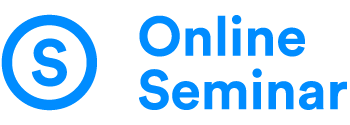More and more companies are using e-learning webinars as a tool for employees or customers. But it’s not that easy to create good webinars that ensure that students finish the course. This is how you use e-learning webinars effectively.
E-learning is on the rise, and rightly so. Webinars enable you to avoid travel and location costs, participants can watch at their own time and the recordings can be reused. So it’s extremely efficient. But that does mean that, as a company, you have to make sure that participants keep watching and don’t click away or answer e-mails in the meantime. So the question is: how do you as a company ensure that you really keep their attention?
Interesting, diverse webinars
In general, people do not find it interesting to watch a ‘talking head’ for an hour, for example: a person in the picture without anything else. People then drop out. Make sure that your webinar is varied. Consider, for example, using different experts and/or (professional) speakers. Also make use of all webinar functionalities, such as polls and the live chat. We always advise you to use them regularly during the webinar. So, for example, present interesting propositions, test the knowledge or ask for the opinion of the participants.
You can also prevent a webinar from becoming boring with a good powerpoint presentation. To do so, it is important that the speaker does not read the text of the slides, but that the presentation is supportive to the story. Do not use much text on the slides. A nice bonus is to alternate them with animations, videos and photos.
In general, a length of one hour per webinar is enough. For some target groups, half an hour works even better. Here again it is important that the information is always valuable and that there is not one hour of talking because it has been communicated that the webinar would be one hour. As soon as you have finished the presentation, just stop the webinar. Even if you haven’t reached the communicated time yet. Participants will continue to be fascinated as soon as the information is interesting or valuable.
It is also important that the webinar never lasts longer than the communicated time. Participants may have another appointment scheduled after the webinar, which means there is a chance that they will drop out. If you expect to run out of time, communicate it. It is better to stop sooner than to continue longer!
Address the target group
If the content is ‘for everyone’, people often don’t find it interesting enough. Also, avoid having people in the webinar for whom the shared knowledge does not apply: this is of no use to anyone. So communicate clearly prior to the webinar what the participant can expect: who exactly is it for and what will the webinar bring them?
The more specific the topic is and the more specific the target group, the more successful the webinar will be. It starts with the headline. Compare, for example, ‘Webinar on inheritance tax’ with ‘The latest legislative changes in inheritance tax for intermediaries: this is what you need to know in order to properly inform your customers’. With the second option, the target group is directly addressed. You then also want to implement this throughout the entire webinar. Always address the target group and involve the participants. Poll questions and other webinar functionalities support this.
Make the content social and accessible
Research shows that the more social the e-learning is, the better it connects. People simply don’t like the feeling of being alone. So it helps a lot if the content is accessible and there is a lot of involvement. Have people ask questions in the chat and ask for their opinion in a poll question. Stimulate interaction. It is best to answer questions live as much as possible and not on a forum in a later stage. That keeps viewers on board.
An additional advantage of interaction is that participants remember the information much better. By contributing, they internalize the information. It is also a good idea to ask the participants which topics they find relevant, for example with a survey. Have the participants ask a question during registration. By doing so you’ll enrich the e-learning and make participants feel more involved.
Good working technology
Participants simply expect that technology will work and that a webinar will be accessible on all devices. We therefore work with very robust technology. This way there are no hiccups during the webinar and chat questions can be immediately answered by the team of moderators behind the scenes. We facilitate the platform on any device. Participants can therefore attend the webinar on the road or at home.
Focus on evaluation
We have created a number of very effective assessment tools. For example, you can ask participants to fill in polls during the webinar. This ensures that they listen attentively. The question is, of course, whether they still remember the information after two months, for example. And whether they really apply the knowledge. That is why it is important to organise e-learning webinars on a frequent basis. In this way, participants know where to find you as a company to gain knowledge and you can build on webinars that you have previously shared. Our golden rule: One webinar is not a webinar.
If the aim of your webinar is gaining accreditation points, it is important to communicate this to the participants in the invitation. The accreditation requirements can also be stated in the invitation. Participants will then take watching the webinar even more seriously.


